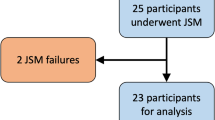Abstract
Relatively inexpensive, portable bone ultrasound systems are of particular relevance to disabled or elderly subjects, who may have problems with access to other forms of densitometry. The effects of local soft tissues on ultrasound measurements are poorly understood and, as ankle oedema is common in such subjects, we examined its consequences for bone ultrasound readings at the heel. Eleven elderly subjects (mean age 81 years) with below-knee pitting oedema were assessed using a direct-contact bone ultrasound system (CUBAClinical). We made a total of 16 series of readings, 6 unilateral and 5 bilateral. In each series an initial reading was followed by repeated pressure over the measurement site to disperse oedema; subsequent readings were thus subject to a progressively lessening degree of local oedema, until a steady state was eventually reached in which no further oedema could be displaced. Heel width fell by a mean of 6.3 mm between initial and steady-state readings; consistent with the clinical appearance of moderate oedema, pitting to a mean depth of only 3.15 mm. Measurements in the presence of oedema were compared with those after its elimination, and oedema was shown to cause a mean reduction of 23.9 m/s in velocity of sound (VOS) and of 5.5 dB/MHz in broadband ultrasound attenuation (BUA). Both changes were equivalent to a fall by a quarter of one standard deviation of the reference range, and were significant atp<0.05 on pairedt-test. As the severity of oedema will vary through the day, and from day to day, measurement protocols for bone ultrasound should pay attention to the confounding effects of oedema.
Similar content being viewed by others
References
Schott AM, Weill-Engerer S, Hans D, et al. Ultrasound discriminates patients with hip fracture equally as well as dual X-ray absorptiometry and independently of bone mineral density. J Bone Miner Res 1995;10:243–9.
Stewart A, Reid DM, Porter RW. Broadband ultrasound attenuation and dual energy X-ray absorptiometry in patients with hip fractures. Which techniques discriminates fracture risk? Calcif Tissue Int 1994;54:466–9.
Porter RW, Miller C, Grainger D, Palmer SB. Prediction of hip fracture in elderly women: a prospective study. BMJ 1990; 301:638–41.
Hans D, Dargent P, Schott AM, et al. Ultrasound parameters predict hip fracture independently of hip bone density: the EPIDOS prospective study. J Bone Miner Res 1995;10:S169.
Bauer DC, Gluer CC, Pressman AR, et al. Broadband ultrasonic attenuation and the risk of fracture: a prospective study. J Bone Miner Res 1995;10:S175.
Heaney RP, Avioli LV, Chesnut CH, Lappe J, Recker RR, Brandenburger GH. Ultrasound velocity through bone predicts incident vertebral deformity. J Bone Miner Res 1995;10:341–5.
Compston JE, Cooper C, Kanis JA. Bone densitometry in clinical practice. BMJ 1995;310:1507–10.
Jones PRM, Hardman AE, Hudson A, et al. Influence of brisk walking on the Broadband Ultrasound Attenuation of the calcaneus in previously sedentary women aged 30–61 years. Calcif Tissue Int 1991;49:112–5.
Hans D, Schott AM, Meunier PJ. Ultrasound assessment of bone: a review. Eur J Med 1993;2:157–63.
Evans WD, Jones EA, Owen GM. Factors affecting the in vivo precision of broadband ultrasound attenuation. Phys Med Biol 1995;40:137–51.
Sloan PD, Baldwin R, Montgomery R, Hargett F, Hartzema A. Left-sided leg oedema in the elderly. J Am Board Fam Pract 1993;6:1–4.
Harris W, Johansen A, Stone MD. Ultrasound MD. Ultrasound assessment of bone strength: development of osteoporosis after stroke. Age Ageing 1996;25(Suppl 1):22.
McCloskey EV, Murray SA, Charlesworth D, et al. Assessment of broadband ultrasound attention in the os calcis in vitro. Clin Sci 1990;78:221–5.
Blake GM, Herd RJ, Miller CG, Fogelman I. Should broadband ultrasonic attenuation be normalised for the width of the calcaneus? Br J Radiol 1994;67:1206–9.
Schott AM, Hans D, Sornay-Rendu E, et al. Ultrasound measurements on os calcis: precision and age-related changes in a normal female population. Osteoporosis Int 1993;3:249–54.
Brandenburger G, Waud K, Baran D. Reproducibility of uncorrected velocity of sound does not indicate true precision. J Bone Miner Res 1992;(Suppl 1):S184.
Miller CG, Herd RJ, Ramalingham T, Fogelman I, Blake GM. Ultrasonic velocity measurements through the calcaneus: which velocity should be measured? Osteoporosis Int 1993;3:31–5.
Kotski PO, Buyck D, Hans D, et al. Influence of fat on ultrasound measurements of the os calcis. Calcified Tissue Int 1994;54:91–5.
Goss SA, Johston RL, Dunn F. Comprehensive compilation of empirical ultrasonic properties of mammalian tissues. J Accoust Soc Am 1978;64:423–57.
Author information
Authors and Affiliations
Rights and permissions
About this article
Cite this article
Johansen, A., Stone, M.D. The effect of ankle oedema on bone ultrasound assessment at the heel. Osteoporosis Int 7, 44–47 (1997). https://doi.org/10.1007/BF01623459
Received:
Accepted:
Issue Date:
DOI: https://doi.org/10.1007/BF01623459




